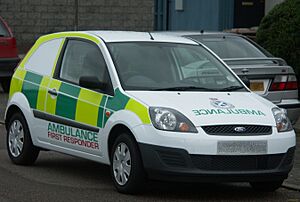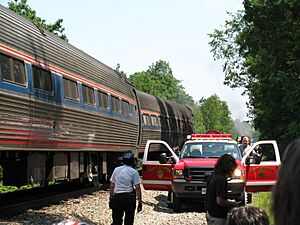First responder facts for kids
A first responder is a brave person with special training. They are usually the first to arrive and help when there's an emergency. Think of them as the front-line heroes!
These important helpers often include:
- Police officers who keep everyone safe.
- Paramedics and EMTs who provide medical care.
- Firefighters who put out fires and rescue people.
- Search and rescue teams who find people in danger.
- Public works teams who help clean up after storms or keep roads clear.
Sometimes, even doctors, nurses in hospitals, or members of the military can be called first responders. This happens especially during big emergencies or disasters.
There are different kinds of first responders depending on their special skills. For example:
- A certified first responder has training to give medical help before an ambulance arrives.
- A community first responder is a volunteer who helps with medical emergencies in their local area until professional help gets there.
- A wilderness first responder is trained to help people in remote places like forests or mountains. They can provide care and help transport patients without motorized vehicles.
- Public works teams are also first responders. They clear snow, fix roads, and provide support during natural disasters.
Contents
What Does "First Responder" Mean?
The term "first responder" became common in the United States during the 1970s. It was used to describe police officers and firefighters who were trained to give basic medical help at an emergency scene. They were the "first" ones to "respond" and offer care before more advanced medical teams arrived.
First Responders in the United States
In the United States, the government has a clear definition for first responders. They are people who are responsible for keeping everyone safe, protecting property, and looking after the environment when an emergency happens.
This group includes many different types of helpers:
- Police, firefighters, and medical emergency teams.
- People who answer 911 calls (dispatchers).
- Hospital emergency staff.
- Public health workers.
- Public works staff who operate heavy equipment or clear roads.
Basically, anyone who gives immediate support during an emergency is considered a first responder. This includes help during prevention, response, and recovery operations.
Challenges for First Responders
Being a first responder is a very important job, but it can also be challenging. They need to be ready for many different types of emergencies. Because their job can be stressful and unpredictable, it's very important for first responders to stay healthy, both physically and mentally.
Staying Safe from Illness
First responders are often the first people to help those who might have an unknown illness. For example, in 2003, some first responders were among the first to get sick with the previously unknown SARS virus because they were caring for patients.
More recently, during the COVID-19 pandemic, keeping first responders safe was a big concern. Health organizations shared important guidelines. These included:
- Asking questions about symptoms before arriving.
- Wearing protective gear like masks and gloves.
- Washing hands often.
- Keeping a safe distance when possible.
- Cleaning equipment very carefully.
These steps help protect first responders so they can continue to help others safely.
Handling Stress and Difficult Situations
First responders often see difficult situations. This can be very stressful. It's important for them to have support and ways to manage this stress. Many organizations offer help and resources to ensure their mental well-being. This support helps them continue their vital work.
See also
- First aid
- Emergency medical responder levels by U.S. state
- Second responder
- Global Prehospital Consortium





